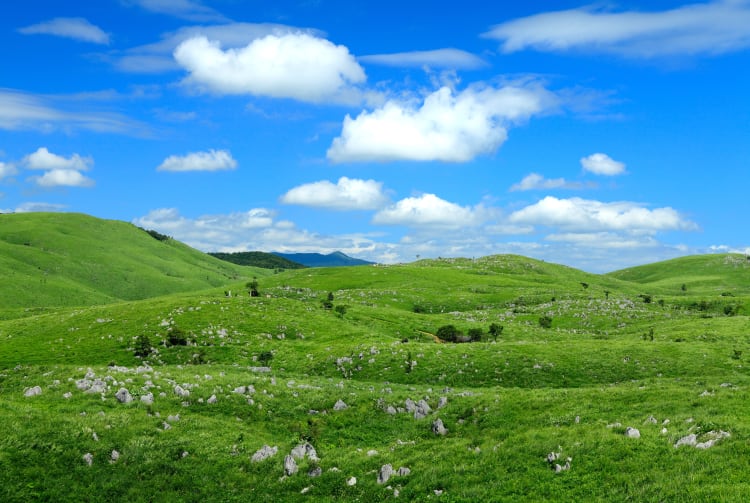A pastoral landscape and Japan's largest limestone caverns
Akiyoshidai Plateau, near the city of Mine in Yamaguchi Prefecture , is unlike anything else you will see in Japan. About 300 million years ago, Akiyoshidai was under the ocean, where a coral reef existed. Over a long period of time, the area was pushed up onto land. Rainwater eroded the land, forming impressive limestone and stalactite formations.
However, before you explore the winding trails that run through this rocky grassland plateau, one should first visit Akiyoshido's undergound caverns, the most extensive cave system in Japan.
Don't Miss
- The limestone pools and terrace inside Akiyoshido
- The “golden pillar,” an enormous stalactite
- The view across Akiyoshidai and the karst landscape
How to Get There
Akiyoshido and Akiyoshidai are accessible via an extensive bus network from Yamaguchi City, and also from other cities throughout the prefecture.
Bocho Buses run from Shin-Yamaguchi Station to Akiyoshido Bus Center. From JR Yamaguchi Station, Chugoku JR buses also run to Akiyoshido Bus Center. Two Bocho buses per day run to Akiyoshidai then on to Akiyoshido from Higashi-Hagi Station.


The caverns of Akiyoshido
Walk through the trees and cross the bridge over the river into the cave known as Akiyoshido.
The cave is large, with a well-maintained boardwalk. Gentle lighting preserves the atmosphere of this incredible place and illuminates the stunning limestone pools, stalactites and stalagmites to great effect. The water running through the cave makes this an aural experience as well as it whittles the limestone into ever-more fantastic shapes.

Walk above the rushing water to enter Akiyoshido

The limestone terrace, "100 plates"
Plates and golden pillars
These caves are Japan's largest, around 11 kilometers total. However, only around one kilometer is open to the public.
There are two very famous places inside the cavern. The first is the "100 plates," a huge terrace of limestone that looks like an enormous stack of overlapping plates, all washed and ready to be used for serving customers. The other is a gigantic stalactite called the "Golden Pillar," more than 15 meters tall and 4 meters in diameter.
There's a special trail you can climb up for an additional 300 yen that takes you higher up for a great view down into the cavern.
The surreal karst topography of Akiyoshidai
An elevator will take you up to Akiyoshidai from inside the cave. The Akiyoshidai Observatory is a five-minute walk uphill from the exit. When you step out onto the grassland, you'll have a breathtaking view of the karst.
Pampas grass was once harvested here for thatch and other uses. The annual controlled burning of the Akiyoshidai Plateau prevents trees from growing to large sizes here. Explore the this extraordinary landscape on foot along a network of walking trails. The contrast of colors—vivid green, rocky white and sky blue—will light your imagination.

Lighting a fire to renew the grasslands
The landscape of Akiyoshi-dai changes with the seasons, and once a year, people change the landscape.
On the third Sunday in February, a controlled burn is conducted at Akiyoshidai to conserve the grasslands. This event is called Akiyoshidai Yama-yaki. Local residents and volunteers set fire to the grasses, and the fire spreads out over the fields, turning everything black and exposing the white rocks.



























































